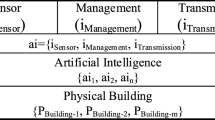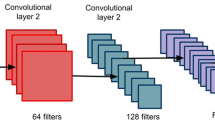Abstract
From an urban planning perspective, accurately predicting urban block carbon emissions (UBCE) based on built environment factors is a good way to minimize UBCE as well as reduce urban heat islands. At a metropolitan level, this study gathered different wellsprings of information and proposed an AI strategy to foresee various elements of UBCE. Based on smart grid greenhouse gas emission and reinforcement learning, this study proposes a novel carbon footprint analysis method for sustainable building construction. In the proposed research, a novel hybrid optical wireless communications (OWC) topic is presented as a contribution to Internet of Things (IoT) devices of smart grids within smart sustainable cities. Among the rapidly evolving fields used in smart cities are OWC and IoT. The construction of the building is made with smart grid-based solar cells, and reinforcement learning is used to find the carbon footprint. The adaptive fuzzy convolutional multi-layer kernel vector neural network is then used to optimize the carbon footprint. It will discuss potential outcomes of structural engineering applications of machine learning and neural networks, and most importantly, it requires professional data from around the world to form a fundamental foundation that will speed up the transition to a more sustainable built environment. In terms of energy consumption, sensitivity, positive and negative predictive values, and training accuracy, the experimental analysis is carried out.







Similar content being viewed by others
Data Availability
All the data’s available in the manuscript.
References
Ahmed, M., Shuai, C., Ahmed, M.: Influencing factors of carbon emissions and their trends in China and India: A machine learning method. Environ. Sci. Pollut. Res. 29(32), 48424–48437 (2022)
Amani, M.A., Sarkodie, S.A.: Mitigating spread of contamination in meat supply chain management using deep learning. Sci. Rep. 12(1), 5037 (2022) (In-Press)
Budennyy, S. A., Lazarev, V. D., Zakharenko, N. N., Korovin, A. N., Plosskaya, O.A., Dimitrov, D. V., … Zhukov, L. E. (2022, December). Eco2ai: carbon emissions tracking of machine learning models as the first step towards sustainable ai. In Doklady Mathematics (Vol. 106, No. Suppl 1, pp. S118-S128). Moscow: Pleiades Publishing
Chen, P., Wu, Y., Zhong, H., Long, Y., Meng, J.: Exploring household emission patterns and driving factors in Japan using machine learning methods. Appl. Energy. 307, 118251 (2022) (In-Press)
Chin, H.H., Varbanov, P.S., You, F., Sher, F., Klemeš, J.J.: Plastic circular economy framework using hybrid machine learning and pinch analysis. Resour. Conserv. Recycl. 184, 106387 (2022) (In-Press)
Elnour, M., Fadli, F., Himeur, Y., Petri, I., Rezgui, Y., Meskin, N., Ahmad, A.M.: Performance and energy optimization of building automation and management systems: Towards smart sustainable carbon-neutral sports facilities. Renew. Sustain. Energy Rev. 162, 112401 (2022) (In-Press)
Fahim, M., Sharma, V., Cao, T.V., Canberk, B., Duong, T.Q.: Machine learning-based digital twin for predictive modeling in wind turbines. IEEE Access. 10, 14184–14194 (2022)
Gupta, S., Li, L.: The potential of machine learning for enhancing CO2 sequestration, storage, transportation, and utilization-based processes: A brief perspective. JOM. 74(2), 414–428 (2022)
Han, Y., Cao, L., Geng, Z., Ping, W., Zuo, X., Fan, J., Lu, G.: Novel economy and carbon emissions prediction model of different countries or regions in the world for energy optimization using improved residual neural network. Sci. Total Emviron. 860, 160410 (2023) (In-Press)
Liu, G., Liu, J., Zhao, J., Qiu, J., Mao, Y., Wu, Z., Wen, F.: Real-time corporate carbon footprint estimation methodology based on appliance identification. IEEE Trans. Industr. Inf. 19(2), 1401–1412 (2022)
Patterson, D., Gonzalez, J., Hölzle, U., Le, Q., Liang, C., Munguia, L.M., Dean, J.: The carbon footprint of machine learning training will plateau, then shrink. Computer 55(7), 18–28 (2022)
Qiu, D., Dong, Z., Zhang, X., Wang, Y., Strbac, G.: Safe reinforcement learning for real-time automatic control in a smart energy-hub. Appl. Energy. 309, 118403 (2022) (In-Press)
Roumiani, A., Mofidi, A.: Predicting ecological footprint based on global macro indicators in G-20 countries using machine learning approaches. Environ. Sci. Pollut. Res., 1–20. (2022)
Selvan, R., Bhagwat, N., Anthony, W., Kanding, L.F., B., Dam, E.B.: Carbon footprint of selecting and training deep learning models for medical image analysis. In Medical Image Computing and Computer Assisted Intervention–MICCAI 2022: 25th International Conference, Singapore, September 18–22, 2022, Proceedings, Part V (pp. 506–516). Cham: Springer Nature Switzerland. (2022), September
Sun, C.: The correlation between green finance and carbon emissions based on improved neural network. Neural Comput. Appl. 34(15), 12399–12413 (2022) (In-Press)
Sun, W., Huang, C.: Predictions of carbon emission intensity based on factor analysis and an improved extreme learning machine from the perspective of carbon emission efficiency. J. Clean. Prod. 338, 130414 (2022)
Tamburrini, G.: The AI carbon footprint and responsibilities of AI scientists. Philosophies. 7(1), 4 (2022) (In-Press)
Ye, L., Yang, D., Dang, Y., Wang, J.: An enhanced multivariable dynamic time-delay discrete grey forecasting model for predicting China’s carbon emissions. Energy. 249, 123681 (2022) (In-Press)
Yu, Y., Mao, J., Wullschleger, S.D., Chen, A., Shi, X., Wang, Y., Pierce, E.: Machine learning–based observation-constrained projections reveal elevated global socioeconomic risks from wildfire. Nat. Commun. 13(1), 1250 (2022) (In-Press)
Zhao, J., Kou, L., Wang, H., He, X., Xiong, Z., Liu, C., Cui, H.: Carbon emission prediction model and analysis in the Yellow River basin based on a machine learning method. Sustainability. 14(10), 6153 (2022)(In-Press)
Zhu, X.H., Lu, K.F., Peng, Z.R., He, H.D., Xu, S.Q.: Spatiotemporal variations of carbon dioxide (CO2) at Urban neighborhood scale: characterization of distribution patterns and contributions of emission sources. Sustain. Cities Soc. 78, 103646 (2022) (In-Press)
Funding
This work was sponsored in part by Internet + Education Special Project in 2020 in the 13th Five-Year Plan of Shanxi Province; Project Name: MOOC-Based Mixed Teaching Model Application Research in Architectural Structure and Map Recognition Course (Project No.: HLW-20185).
Author information
Authors and Affiliations
Contributions
XL Study conception and design: data collection: TW analysis and interpretation of results: draft manuscript preparation: LL All authors reviewed the results and approved the final version of the manuscript.
Corresponding author
Ethics declarations
Conflict of interest
The authors declare no competing interests.
Ethical approval
This article does not contain any studies with animals performed by any of the authors.
Additional information
Publisher’s Note
Springer Nature remains neutral with regard to jurisdictional claims in published maps and institutional affiliations.
Rights and permissions
Springer Nature or its licensor (e.g. a society or other partner) holds exclusive rights to this article under a publishing agreement with the author(s) or other rightsholder(s); author self-archiving of the accepted manuscript version of this article is solely governed by the terms of such publishing agreement and applicable law.
About this article
Cite this article
Li, X., Wang, T. & Li, L. Impact optical communication model in sustainable building construction over the carbon footprint detection using quantum networks. Opt Quant Electron 55, 912 (2023). https://doi.org/10.1007/s11082-023-05191-z
Received:
Accepted:
Published:
DOI: https://doi.org/10.1007/s11082-023-05191-z




